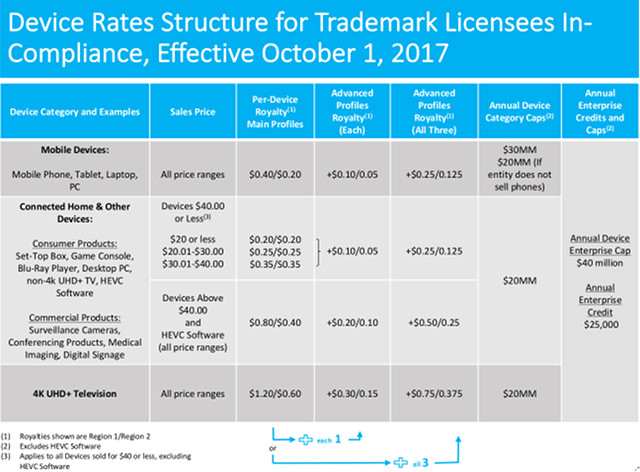Most video codecs such as H.264, H265/HEVC, MPEG-2, MPEG-4… requires the manufacturer to pay a license fee. The fees are then added to the final product, but the actual codec fees are usually unknown to the end user. One of the exceptions are VC-1 and MPEG-2 license fees for Raspberry pi boards which are sold separately for respectively £1.20 ($1.58 US) and £2.40 ($3.16 US).
So I assumed that licenses pricing was mostly private and negotiated based on volume. But a recent article stated that HEVC Advance, independent licensing administrator, revised the royalties for lower-price devices (<$40) with the price table below providing a good insight into pricing for different device types, unit prices and regions.

The new discounted royalty rate category applied to consumer and commercial products selling for less than $40 including set-top boxes, surveillance cameras, game console and others. A simplified Patent License Agreement (PPL) was also announced in order to reduce costs for licensees.
The table above requires some explanations:
- Region 1/2 – Region 1 is comprised of countries with higher GPD per capita, and Region 2 are all other countries, mostly developing countries.
- Advance Profiles Extension – Additions to version 2 of HEVC specifications with RExt, MV-HEVC and SHVC (3 profiles).
- Three main categories of devices for licenses:
- Mobile Devices
- Connected Home & Other Devices
- 4K UHD+ TV
The license is apparently applied to the country of sale or manufacture, and “if there are no patents in both the country of manufacture and the country of sale, then no royalties are due for HEVC”. Those licenses appear to be for manufacturers, so I don’t know if silicon vendors pay a license too. I also don’t understand what happens to those TV boxes sold from China, and shipped to various countries around the world, how is the licensee fee calculated, if any? Comments are welcome.
The good news is that in case HEVC license fees are indeed paid in China, cheap devices with H.265 codec should become even cheaper with up to 85 cents less royalities to be paid per devices.
Thanks to Theguyuk for the tip.

Jean-Luc started CNX Software in 2010 as a part-time endeavor, before quitting his job as a software engineering manager, and starting to write daily news, and reviews full time later in 2011.
Support CNX Software! Donate via cryptocurrencies, become a Patron on Patreon, or purchase goods on Amazon or Aliexpress




